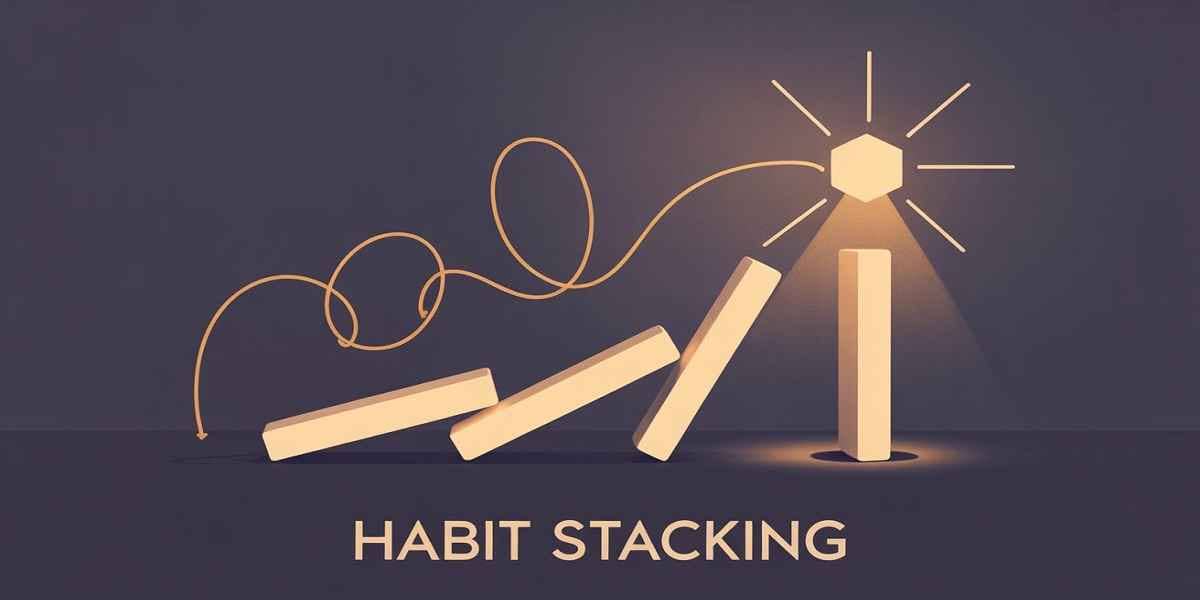
Have You Ever Wondered How Habit Stacking Can Change Your Life?
You’ve probably tried starting a new habit before. Maybe it worked for a few days. Then life got in the way. Sound familiar? Habit stacking might be the answer you’re looking for. It’s a simple, practical way to build unshakeable consistency without relying on endless willpower. Want to know how it works? Let’s dive in.
What’s Habit Stacking All About?
Imagine this: you already do certain things every day without thinking. Brushing your teeth. Making coffee. Checking your phone. Habit stacking takes those automatic routines and uses them to kickstart new behaviors. You attach something new, like drinking water or stretching, to something you already do. It’s that easy.
For example, say you brew coffee every morning. Right after, you could stack a habit of doing ten squats. The coffee becomes your trigger. Over time, the two actions feel like one. That’s how habit stacking sneaks new routines into your day. No stress. No fuss.
Why does this matter to you? Because building habits shouldn’t feel like a battle. You’re busy. You’ve got a million things on your plate. Habit stacking makes consistency doable by piggybacking on what’s already working.
Why Unshakeable Consistency Matters
Consistency is the secret sauce to progress. But let’s be real, it’s hard to keep up when motivation fades. That’s where habit stacking shines. It turns small actions into a chain that’s tough to break. One habit triggers the next. Before you know it, you’ve got a routine that sticks.
Think about it. What if you could trust yourself to follow through every day? Not because you’re superhuman, but because your system makes it effortless. That’s unshakeable consistency in action. It’s not about big wins overnight. It’s about tiny steps that add up.
Here’s the kicker: habit stacking doesn’t just build one habit. It creates a ripple effect. You start with something small, like reading some pages after breakfast. Soon, you’re stacking more. Maybe journaling. Then meditating. Suddenly, your mornings are transformed. All because you started with one simple link.
How to Start Habit Stacking Today
Ready to give it a shot? You don’t need a fancy plan. Just follow these steps:
- Pick a Trigger: Find a habit you already do every day. Something reliable, like brushing your teeth or putting on your shoes. It’s your anchor.
- Choose a Small Habit: Don’t overthink it. Start tiny. Maybe five push-ups. Or a deep breath. Small wins build momentum.
- Link Them Together: Use this formula: “After I (Current Habit), I will (New Habit).” For example, “After I brush my teeth, I’ll drink a glass of water.” Clear. Simple.
- Do It Daily: Repetition is your friend. Stick with it. Even if you miss a day, jump back in tomorrow.
- Build on It: Once it feels natural, add another habit. Slow and steady. That’s the key.
See how straightforward that is? You’re not reinventing your life. You’re tweaking it. Bit by bit.
Real Examples You Can Try
Let’s make this concrete. Want to read more? Stack it with something you already do. “After I pour my morning coffee, I’ll read ten pages.” That’s it. One page a day turns into a book a month. Not bad, right?
Or maybe you want to move more. Try this: “After I sit down for dinner, I’ll stand up and stretch for 5 minutes.” It’s quick. It’s easy. But it adds up.
How about mindfulness? “After I turn off my laptop, I’ll take five deep breaths.” You’re already shutting down for the day. Why not tack on a moment of calm?
These examples show how flexible habit stacking can be. It fits your life, not the other way around. What habit do you want to start?
Why This Actually Works
Ever notice how hard it is to start something new? That’s because your brain hates extra effort. Habit stacking cuts through that resistance. It uses what’s already there. No need to carve out time or summon willpower. Your existing routine does the heavy lifting.
Plus, it builds momentum. Each time you follow through, you feel a little win. Those wins stack up, pun intended. They make you want to keep going. It’s psychology in your favor.
And here’s a gem from Charles Duhigg, author of The Power of Habit: “Change might not be fast and it isn’t always easy. But with time and effort, almost any habit can be reshaped.” Habit stacking proves that. It’s the slow, steady path to reshaping your days.
Watch Out for These Traps
You’re excited. You want to stack all the habits at once. Hold up. That’s a recipe for burnout. Start with one. Let it settle. Then add more.
Another mistake? Picking a shaky trigger. If you don’t always make coffee, it’s a bad anchor. Choose something rock-solid. Like waking up. Or eating lunch.
And don’t go big right away. “After I shower, I’ll run five miles” might sound noble. But it’s too much. Scale it back. Try a one-minute stretch instead. You can grow from there.
Patience is your ally here. Habits don’t lock in overnight. Give it time. You’ll get there.
Tracking Your Wins
Want to see how far you’ve come? Track it. Grab a notebook. Or use an app. Each day you nail your stacked habit, check it off. Watching that streak grow feels good. It keeps you hooked.
Missed a day? No big deal. Life happens. Just don’t let one slip turn into a slide. Pick it up the next day. Consistency isn’t perfection, it’s persistence.
Level Up with Habit Chains
Once you’ve got one stack down, why stop? Build a chain. Here’s an example:
- After I wake up, I’ll make my bed.
- After I make my bed, I’ll drink water.
- After I drink water, I’ll stretch for two minutes.
Boom. Three habits in a row. It’s like a mini morning ritual. Each step flows into the next. You’re not just stacking habits, you’re crafting a lifestyle.
Habit Stacking for Every Goal
This isn’t just for fitness buffs or productivity gurus. It’s for you, whatever you’re chasing. Health? Stack a quick walk after lunch. Work? Review your goals after your first email. Relationships? Text a friend after you lock the door at night.
Learning something new? Stack a vocab word after you brush your teeth. Creativity? Jot an idea after you eat breakfast. It’s endless. What’s your goal? There’s a stack for it.
The Ripple Effect Over Time
Here’s where it gets exciting. Habit stacking isn’t about instant change. It’s about the long game. One small habit today, like flossing after brushing, seems minor. But a year from now? Your dentist is thrilled. Five years? Your health’s better.
Stack a few more. Exercise. Reading. Gratitude. Suddenly, you’re fitter, smarter, happier. All from little links in your day. That’s the power of unshakeable consistency. It’s quiet. It’s steady. But it’s unstoppable.
Your Turn to Stack
So, what do you think? Habit stacking isn’t magic. It’s a tool. A damn good one. It takes your messy, busy life and slips new habits right in. No drama. Just results. You can build unshakeable consistency starting today. One small stack at a time.
What’s your first stack going to be? Pick a trigger. Choose a habit. Try it tomorrow. Then tell me how it goes. Drop a comment below, I’d love to hear your story. Let’s build something unshakable together.
FAQs
Q1. What is habit stacking?
A1. Habit stacking is a technique where you attach a new habit to an existing one, using the established habit as a trigger for the new behavior. For example, if you brush your teeth every morning, you could stack a habit like doing ten squats immediately afterward.
Q2. How does habit stacking help with consistency?
A2. Habit stacking helps with consistency by linking new habits to routines you already do regularly. This connection makes it easier to remember and perform the new behavior, as the existing habit serves as a reliable cue, reducing reliance on motivation or willpower.
Q3. What are some examples of habit stacking?
A3. Here are a few examples
- Doing squats after brushing your teeth.
- Reading one page of a book after making your morning coffee.
- Taking five deep breaths after turning off your laptop.
- Stretching for 30 seconds after sitting down for dinner.
Q4. Why is it important to start with small habits when stacking?
A4. Starting with small habits is key because they’re easier to adopt and more likely to stick. Small successes build momentum and confidence, paving the way for bigger changes over time.
Q5. What are some common mistakes to avoid with habit stacking?
A5. Common mistakes to avoid include
- Trying to stack too many habits at once, which can overwhelm you.
- Choosing unreliable triggers that aren’t consistent in your routine.
- Setting overly ambitious goals, like aiming for an hour of exercise instead of a short, manageable task.
Q6. Why does habit stacking work?
A6. Habit stacking is effective because it taps into the brain’s natural pattern-following behavior, often described as the “Cue-Routine-Reward” loop. In this method, an existing habit serves as the cue, prompting you to perform the new behavior (Routine) you want to adopt. By linking the new habit to something you already do consistently, it becomes easier to remember and carry out, increasing the likelihood of success.
Q7. How do I choose which habits to stack?
A7. To choose habits for stacking, start with small, manageable ones that support your larger goals. For instance, if your goal is to read more, you might stack reading one page right after brushing your teeth. Pick habits that are simple to integrate into your routine and can grow over time, ensuring they feel natural and sustainable within your daily life.
Q8. How long does it take to form a new habit with habit stacking?
A8. Forming a new habit through habit stacking can take anywhere from 18 to 254 days, with research suggesting an average of about 66 days. The exact time depends on the individual and the habit, but consistency is the key factor. By practicing your stacked habit daily and tying it to a reliable trigger, you’ll gradually make it a seamless part of your routine.
Tags: Habit Stacking Consistency Productivity Self-Improvement Routine Behavior Change Goal Setting Motivation Mindfulness Health Wellness Lifestyle














